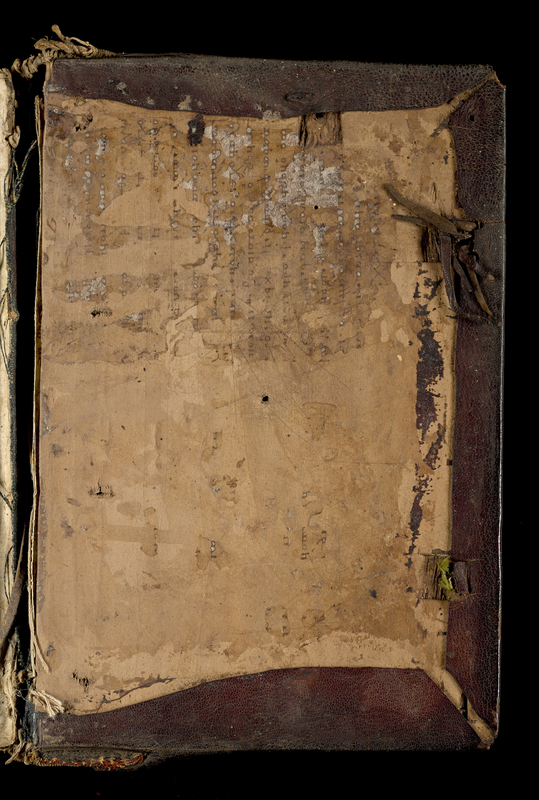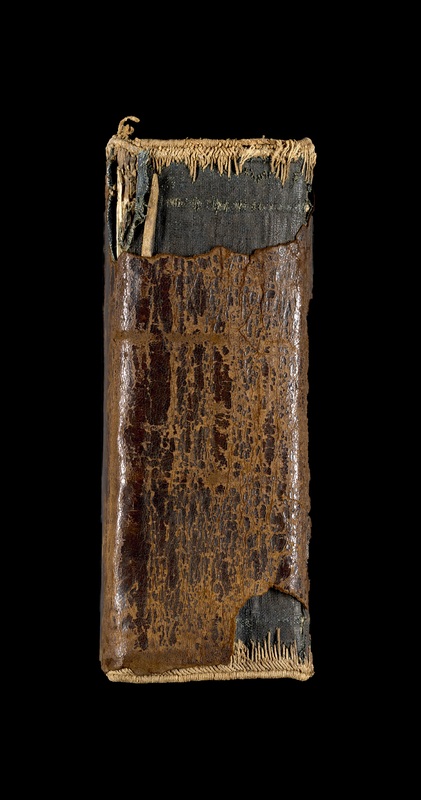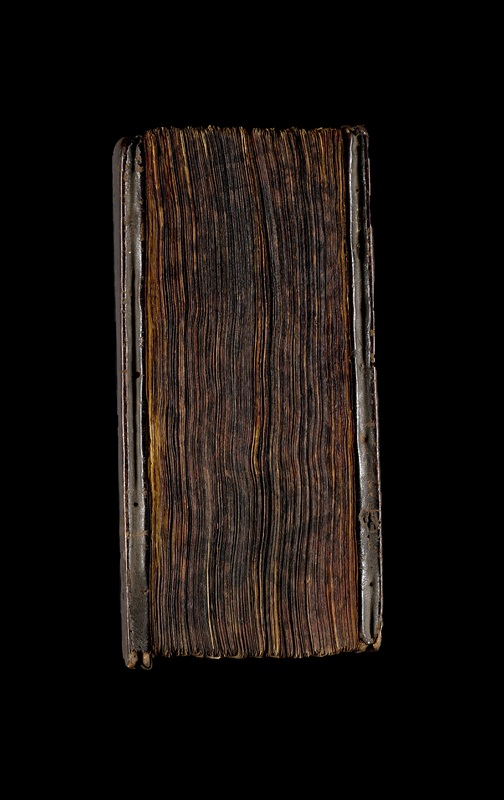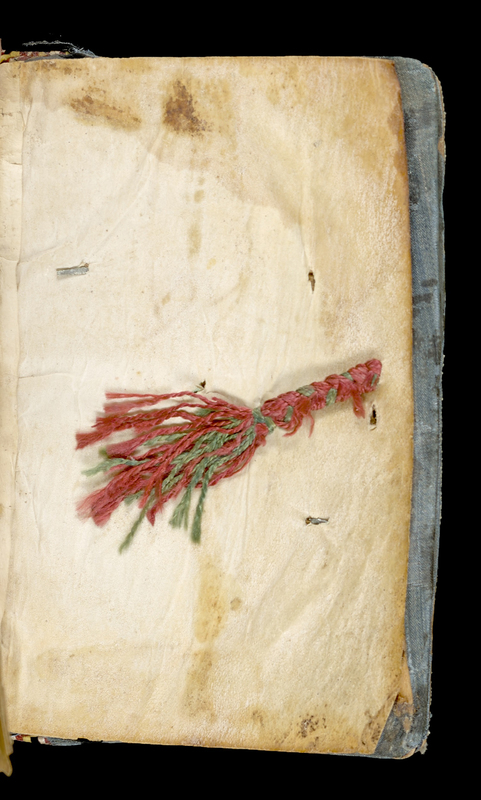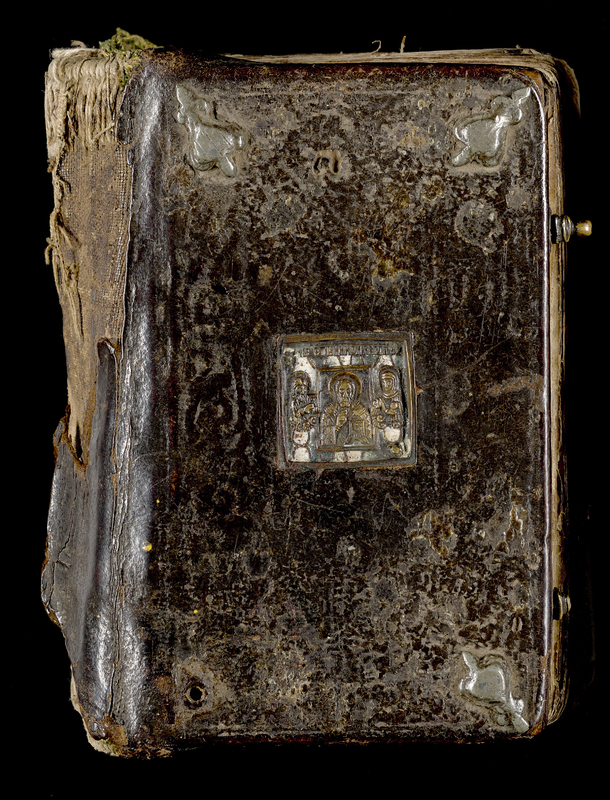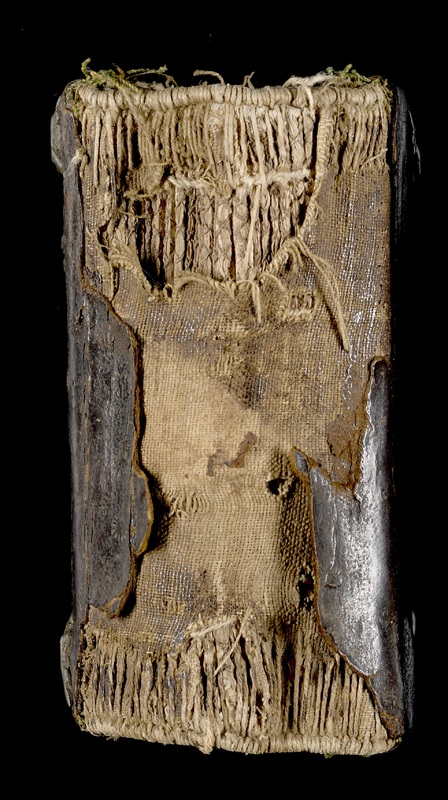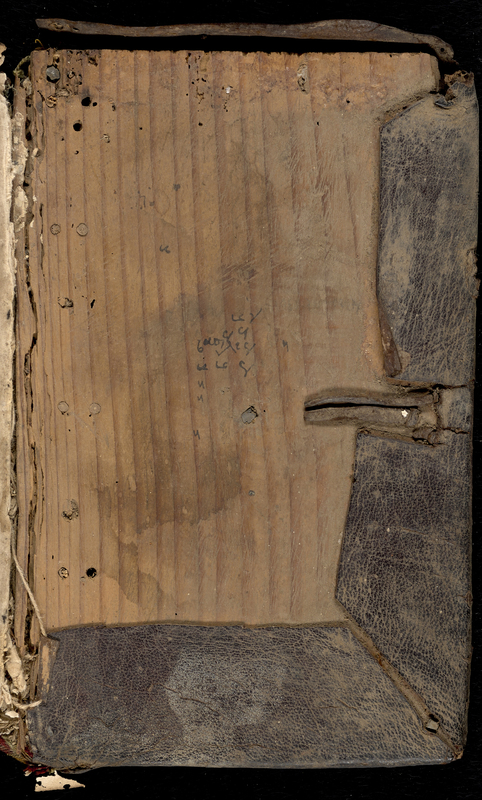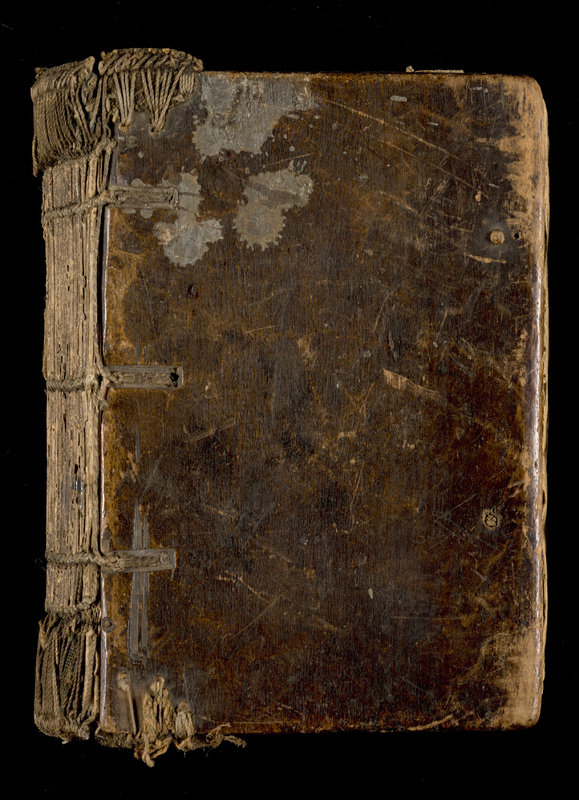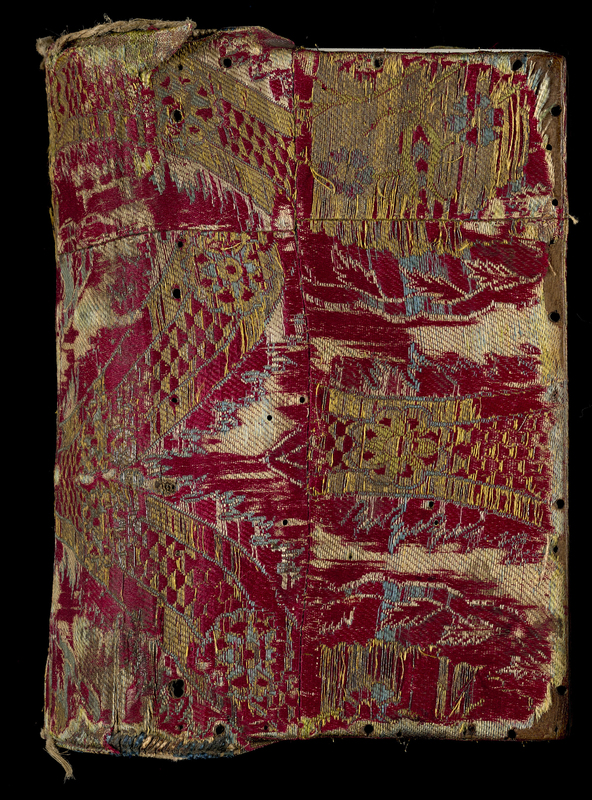The Bindings
This section of the exhibit is greatly indebted to Julia Miller's Tradition and Individuality: Bindings from the University of Michigan Greek Manuscript Collection. Introduction by Pablo Alvarez. With contributions by Kyle Clark. Ann Arbor, MI: The Legacy Press, 2021. In this extraordinary volume, each of the extant bindings in our collection (whether they are contemporary to the date the manuscript was copied or not) are meticulously described, including their material, structure, and decoration. This type of information incredibly enhances our understanding of the history and production of these manuscripts, placing them in a broader cultural context. Occassionally, the style of decoration of a binding even allows us to link a manuscript with a particular monastery, such as the monastery Nicholas Anapausas in the Meteora.
While some of these bindings display the elements of the Greek binding tradition, others include features revealing the artisan's bold individual choices. Nevertheless, as Miller argues, we also need to be cautious, and precise, about what these labels really mean, since binding traditions did not exist in isolation but often grew within multicultural communities. Indeed, traditionally bound Greek manuscripts share features commonly known as Nearn Eastern, a broad binding tradition that include Coptic, Ethiopian, Syriac, Greek, Georgian, Islamic, Slavic, and Armenian.
Shown above is an image of the front cover of Mich. Ms. 172. Note the decoration: a tooled design in concentric-panel style, with line tools and rectangular stamps used to form borders, and small individual tools/stamps used to decorate the resulting compartments, including large and small filled rhombs, round and square filled shapes, and two-ring circles. Note the abrasion, and, although it is difficult to see, the intentional hole in the center of the cover — evidence that the binding once had centerpiece attachments. There is a glint of indigo blue along the edge of the leather at the upper right corner — evidence that the spine lining extended all the way to the fore edge.
Mich. Ms. 172 is bound with a traditional Greek binding, possibly contemporary with the parchment manuscript (13th century CE). The binding elements that qualify it as a Greek binding include the use of dark red-brown goatskin over grooved 10 mm. thick wooden boards, unsupported link-style sewing, a surprising indigo-blue cloth overall spine lining, projecting double-core primary and secondary endbands anchored on the boards, typical blind-tooled decoration, and peg-and-strap style fastenings. The board edges are grooved corner-to-corner, and the leather turn-ins are pegged in the corners of the grooves to hold the leather in place.
In the image above we can see the inside of the back cover of Mich. Ms. 172. Note two hinging stations drilled near the spine, four recesses cut into the wood (one on the head, another on the tail, and two others on the fore edge), and evidence of fastening straps — but only two holes for fastenings are drilled through the board along the fore edge, indicating this may be a reused board. Note also the hole in the center of the board, and ink offset on the wood.
The image above shows the spine of Mich. Ms. 172. Note how the loss areas reveal that the indigo-blue spine lining extends all the way across both boards to the fore edges, using a large piece of an expensively dyed cloth. See that the endband tie downs at head and tail are sharply visible against the blue.
The image above shows the fore edge of Mich. Ms. 172. It is painted, possibly with a large star pattern done in red and black, but the edges have darkened over time and the design is indistinct. The head edge is titled in red, also faint.
Above is an image of the front cover of Mich. Ms. 24. Note the damaged silk cover, the brass plaquette decorated with blue enamel (also present on the back cover; both are eighteenth-century Russian icons), the brass nail heads, and the four domed metal bosses.
The plaquette on this front cover represents a “Deesis," that is, a tripartite icon showing Jesus Christ Pantocrator in the center, with the inscription above him, ΙΣ ΧΣ. Christ is enthroned by the Virgin on the left, with the inscription above her, ΜΠ ΘΥ, and St. John on the right, with the inscription, ΣΤ ΙΩΑΝ. The following line is in Russian. According to Kavrus-Hoffmann, the presence of these eighteenth-century Russian icons suggests that the owner of this manuscript probably went on a pilgrimage to the Russian monastery of Vygoretsky, where he acquired those icons.
The image above shows the inside of the back cover of Mich. Ms. 24. In this image one can appreciate some of the features that characterize traditional Greek bindings: wooden boards (5 mm. thick), projecting endbands anchored on the boards (possibly later endbands, probably added at the time the binding was repaired), and a single edge-fastening of the peg-and-strap variety. The peg is metal (not seen in this image) and the strap is braided using red and green threads.
The image above shows the spine and front cover of Mich. Ms. 24. Note the signs of repair: the original blue silk covering was removed from the boards and replaced by a coarser blue linen cloth covering the spine; the old silk, clearly very fragile, was then reattached to the covers. A red cloth leaf tab marker (not seen in this image) is attached to one parchment leaf of the manuscript.
Shown above is an image of the front cover and part of the spine of Mich. Ms. 26. Note the very faint pattern of blind tooling in the form of stamped foliate designs; the three silver bosses on each cover, which are typical of those seen on other Greek bindings, with a stylized fleur-de-lis shape; the central brass plaquette decorated with blue enamel; and two edge pegs: one brass peg with a bolster is intact, and just the bolster remains of the second peg.
The brass plaquette, a small eighteenth-century icon, depicts St. Nicholas flanked by the figures of Christ on the left and the Virgin Mary on the right. The icon is described in Russian with the exception of the conventional Greek initials to designate Christ and the Virgin respectively, ΙΣ ΧΣ, ΜΡ ΘΟΥ. This small icon was likely produced in the Vygoretsky community in the eighteenth century and brought from Russia by a pilgrim, possibly along with the icons adorning the covers of Mich. Ms. 24.
The binding of Mich. Ms. 26 is traditional Greek, but the paper manuscript was extensively repaired and then resewn at some point, raising the question of whether the present boards, spine lining, and leather covers are original, contemporary with the manuscript (13th or 14th century CE), and were reattached after the repairs. The binding is dark-brown goatskin over 10 mm. thick boards with square edges, a plain cloth overall spine lining, and projecting endbands anchored on the boards. The primary endbands are plain thread with green-silk secondary wraps.
The image above shows the spine of Mich. Ms. 26. Note that the leather of the spine is mostly missing, revealing the plain spine lining and sewing repair system. There is some very faint blind tooling on the cover fragment.
The resewing was done in an interesting style also seen on Mich. Ms. 22: the sheets forming each gathering were cross-stitched down the fold area in a line of “x’s,” bridging and reinforcing the fold area. The repaired gatherings were then sewn in double-sequence style, half the book sewn with each board and the two halves joined by a thread travelling down the middle, looping around each of the four sewing stations.
Shown above is an image of the front cover of Mich. Ms. 47. The decoration includes blind tooling: line tools and rectangular filled stamps creating borders and a center panel bisected with lines to form a saltire design; small, medium and large handle tools fill the compartments: a three-ring circle tool, two sizes of filled rhombs, and a round tool with double-headed eagles. The tooling pattern appears to be symmetrical on both covers; the spine is decorated with lines and the three-ring circle tool in a saltire pattern. Some of these same tools are found on other bindings from St. Nicholas Anapausas in the U-M collection. Cover furniture (attachments such as bosses) include eight-pointed star bosses in the center of each cover, and four corner bosses shaped like stylized fleur-de-lis, similar to those on the cover of Mich. Ms. 26, probably made of silver. Several shanks-ends attaching the bosses to the boards are visible inside the covers. The metal fastening peg is present, set in the fore edge of the upper cover; only the leather ends remain of the fastening strap.
The binding is Greek and probably contemporary with the paper manuscript (14th century CE); it is believed the manuscript was bound at the monastery of St. Nicholas Anapausas in the Meteora complex located in the northwestern edge of Thessaly (Greece). Traditional structural elements include wooden boards 7 mm. thick with square edges, the boards covered in dark-brown goatskin, probable sewn-board construction, a blue-green cloth overall spine lining, projecting primary endbands of natural linen thread anchored on the boards, with secondary endbands of red, green, and yellow thread woven on the primary, and a single peg-and-strap style edge fastening. There is some evidence the boards may have been recycled from use on a different manuscript.
Above is an image of the inside of the back cover of Mich. Ms. 47. Note that the pastedown is missing, revealing wide turn-ins with mitered corners. There are holes along the spine edge, most plugged with wooden pegs. Note the tail of the fastening strap near the fore edge, and see the blunt ends of metal shanks belonging to the bosses.
Shown above is an image of the front board and part of the spine of Mich. Ms. 130. The leather is entirely gone from the spine and back board, so you can see the strongly crafted structural elements of this binding in the bridle preparation, sewing, and endbanding. The boards have acquired a patina over many years that heightens the contours of the wood. Note the stubs of two wooden side pegs near the fore edge.
Mich. Ms. 130 has a Greek binding contemporary with the date of the paper manuscript (1552/3 by colophon). Traditional structural features, beautifully made, are on full display on this binding because it has completely lost its covering, making it a “skeleton” binding of immense use to scholars interested in seeing all the underlying elements of Greek binding structure.
Features include the 7 mm. thick wooden boards, the surfaces showing tool marks, three sets of channels cut in the board faces to carry bridling thread for sewn-board construction, unsupported link-style sewing of the text gatherings (quires) done in double-sequence style (also termed “biaxial stitch disposition”), evidence of a cloth spine lining in fragments caught beneath endband tie downs at head and tail, sturdy projecting endbands of thick natural-tone thread with no evidence of secondary wrapping, and a variation of peg-and-strap fastening in the form of fragments of two wooden side pegs on the upper cover and two partial, flat leather straps on the lower cover.
Evidence the binding was covered, probably by leather, is seen inside the boards in the staining left by the turn-ins, now lacking. There is evidence of a thread loop bound in at the head of the spine; the loop would have carried one or more long threads used to mark a location in the manuscript.
The image above shows the front cover and part of the spine of Mich. Ms. 30. Note the pieced-brocade cover with what appears to be a pattern of intentional holes drilled through the board along the head, fore, and tail edges, indicating that the brocade covering may have been pegged in place along the board edges, or perhaps carried small decorative knobs or bosses. There is also evidence that the binding had two edge fastenings in the form of holes drilled in the fore edge of the front cover.
Mich. Ms. 30 is an example of an expertly and solidly-constructed traditional Greek binding contemporary with the date of the paper manuscript (dated by colophon May 31, 1430).
Traditional structural elements are easily observed due to the loss of part of the pieced-brocade covering and the spine lining: four sewing stations corresponding to the zig-zag bridles on the 12 mm. thick wooden boards, and the boards flush with the manuscript edges. The sewing is done in unsupported link style. The plain cloth overall spine lining extends about 35 mm. onto the board surfaces. The beautiful projecting endbands are composed of a plain primary endband, anchored on the boards, with a secondary endband of blue and white thread woven in a chevron pattern. They are in relatively good condition. Fragments of the leather straps are observable on the back cover, inside and out. The pieced nature of the brocade is evidence of the frugality of the binder; such cloth, even small pieces of it, was valuable.

The Monasteries

About the Exhibit


